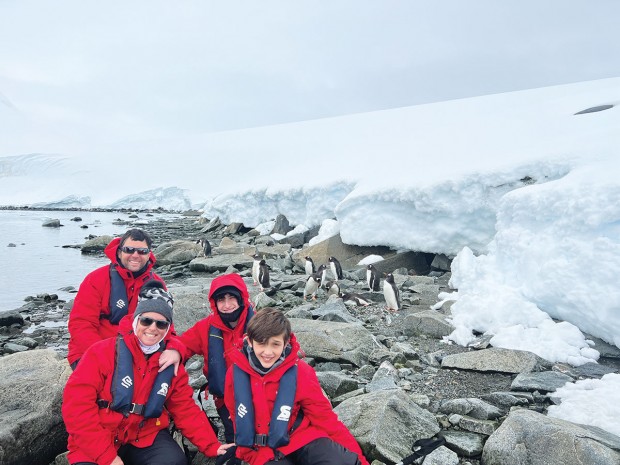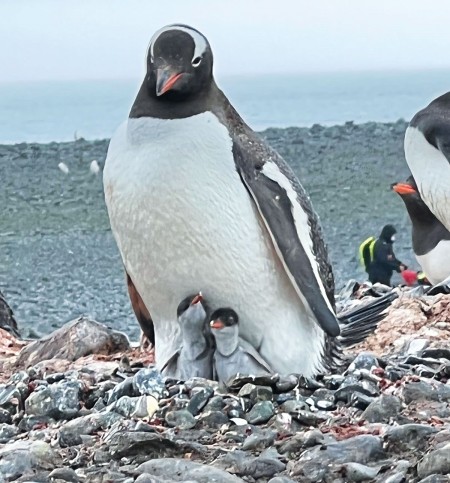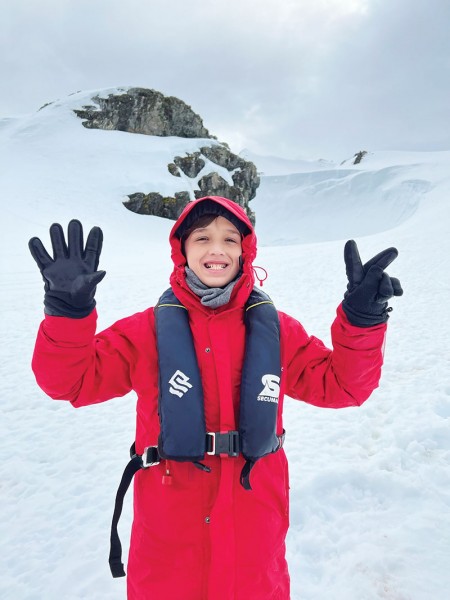Voyage to the bottom of the world

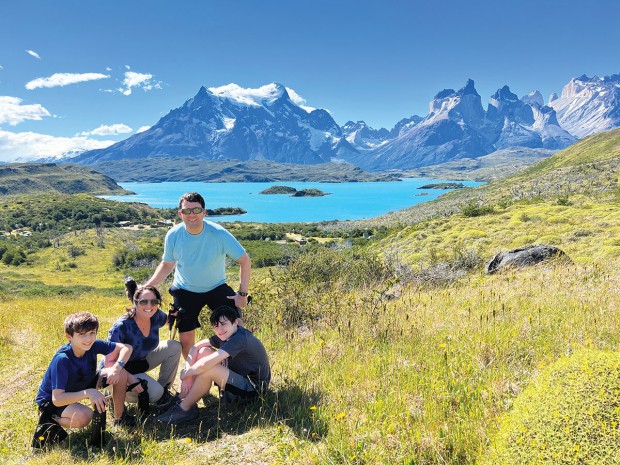
PICTURESQUE PATAGONIA The Kramer family made a stop on their way to Antarctica to check off another bucket-list experience: Torres del Paine National Park in Chile’s Patagonia. Pictured, from left, are Dylan, Jennifer, Adam, and Hayden Kramer. “Torres” means towers in Spanish, and Paine means “blue” in the native Mapuche language.
Seeing the world has always been a top priority for Adam and Jennifer Kramer and doing it with their two sons has made it extra-special. Hayden, their eldest, got his first passport stamp when he was just three months old – Costa Rica – and they’ve traveled internationally with the boys ever since.
By the time Hayden and Dylan were teenagers, they’d already been to six continents – only Antarctica remained. For Adam, a sustainability manager for KBR Inc., the opportunity for his family to connect with one of the world’s last unspoiled wilderness areas had been calling to him for some time. Jennifer wanted to go too but she wanted to wait until the boys were old enough to really appreciate and remember it.
They started making plans in late 2019 – but then the pandemic hit. Jennifer, an epidemiologist, was on the wary side; throughout the pandemic, the globetrotting family stayed stateside. “But I just kept thinking, in two years things will be better.” So the family began planning the epic adventure.
The best way to see Antarctica is through a cruise, but most require a day and a half trip through the Drake Passage, one of the world’s most treacherous voyages. Adam, notoriously prone to seasickness, wanted to find a way around that.
A handful of cruise companies were offering fly-cruise packages, and Silversea Cruises became the first luxury cruise line to do so in 2019. That enabled them to fly directly to King George Island, on the edge of the Antarctica continent, for a six-day cruise.
But first, they planned an important stop along the way: the spectacular Torres del Paine National Park in Chile’s Patagonia. Known for its crystalline glacier lakes, soaring mountains, and vast wildlife-filled pampas, it had been on their bucket list for some time. They chose an adventure resort called Explora, which they’d also stayed in a few years before when they went to Easter Island.
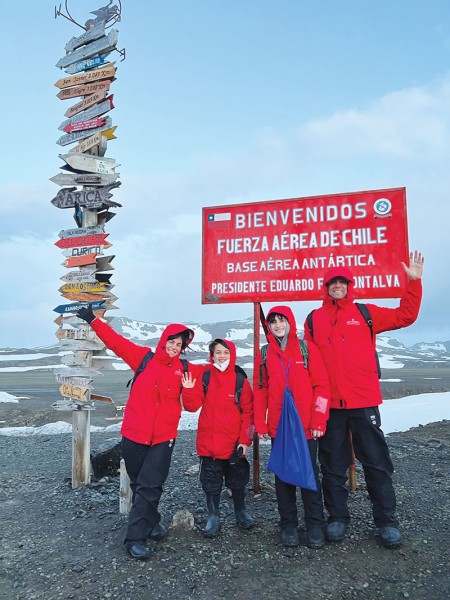
The family gets their first glimpse of Antarctica at a broad-daylight midnight landing at the Chilean research station on King George Island.
All the pieces were falling into place – but as their trip approached, omicron hit. They all had their vaccines, so they decided to stay the course.
“We hadn’t left the country in two years,” she said. “I was very wary; I wanted to be vaccinated, I wanted to be responsible.” So, she studied and followed all the requirements – “I likened Chile to Fort Knox. You had to upload your passports, your vaccine cards, and a negative PCR before you left, and then you had to get another PCR test in the airport. Then you had to go to the hotel room and quarantine until you got the results of that test.”
They landed in Santiago, Chile on Dec. 16 at 8:50 a.m. and headed straight to their hotel. It was 6 p.m. when they got their negative Covid test results, and they went up to the rooftop bar and enjoyed a drink.
“I got teary-eyed being back in the saddle of international travel,” Jennifer said. “Finally, we’re outside of the country seeing the world again.”
They ended up having six Covid tests throughout the trip – there was a small outbreak on the cruise ship, and the cruise line flew a medical team to Antarctica, who tested everyone before letting them return to Chile.
They were lucky: all the tests were negative.
“I know other people who went to Mexico, and they ended up testing positive and getting stuck there,” she said.
Torres del Paine was about as far from Cancun as one could get.
“It was magical,” said Adam. The Explora lodge was at the heart of the park on a river, at the edge of a waterfall, with breathtaking views of the Paine Massif Mountain range. The sky was crystal clear. “It just looks like you would want the sky to look,” he said.
But best of all were the outings. “What’s great about Explora is it’s like camp for adults,” Adam described it. They were outfitted for two treks a day and immersing themselves in nature was the focus.
“It was just alive, with animals running around, and there’s such a huge amount of plant life there,” said Adam. The park is home to pumas and condors, endangered huemul deer, an ostrich-like bird called the Darwin’s rhea, and a llama-like creature called a guanaco, among many others. For Adam, spending time in landscapes like this one, far from the city, is one of the most meaningful things in life.
“There’s a feeling of deep peace…and I see it in my wife and children, too, there’s a calmness you get from being outside,” Adam reflected. “The trees, the mountains, the water, all these things are symbiotic and working together to provide this life force for all of us. It’s really great to see it.”
Soon it was time to head to Punta Arenas, where the cruise started. They were fitted with parkas, waterproof pants, boots, and backpacks. They awoke early and prepared for the journey, and then waited at the hotel for word from the crew – because nobody knew what time they would fly.
“You just wait for the best conditions of weather to break, and for us it was 10 p.m.,” said Jennifer. “But remember we are in Antarctica in the summertime – so it’s still broad daylight.”
They had a meal on the hour-and-a-half flight and then were told to don their gear before landing on King George Island at nearly 11:30.
They landed in an “Martian-like” landscape on the Chilean Air Force Base, as Jennifer tells it, and set off on a mile-and-a-half walk, single-file, through the wind and snow and midnight sun, to the beach. They were given life jackets and divided into groups of eight and whisked away on Zodiacs to the ship – where a hot buffet awaited them.
The next day they began their exploration of that otherworldly landscape, usually two landings a day, stopping at a series of islands, on an ice shelf, and finally on the mainland itself.
It was indescribable, but Adam gave it a try. “It’s a huge amount of beautiful snow and ice, really sculpturesque, with all the extremely blue ice from the huge glaciers in the water.”
He had taken the family to Greenland, which he expected to be similar, but it was “totally different.” Greenland is home to the world’s second most productive glacier. “But that’s like kids’ play when you go to Antarctica. There you see icebergs several times the size of ships – and that’s the small ones, and only the top part, because almost 90 percent of the iceberg is below the water.”
The Kramers were there over the December solstice, right at the height of the Antarctic summer, and the constant light makes for a strange feeling. “No one’s tired; there’s a lot of energy,” said Adam. It felt a bit like being on the moon, he said – like nothing any of them had ever experienced.
“It’s an enormous continent, as far as the eye can see, and you don’t see human populations – you could call it desolate, but I enjoyed that feeling, like no one had been there before. That was the special nature of it; it gave you the feeling it was not of this world.”
Then there was the wildlife, of which there was plenty – seals, dolphins, humpbacks, orcas, birds, and above all the penguins.
“There were thousands of them. It was just massive,” said Adam. “There were penguins as far as you could see, and they were hatching all these little babies – and we were able to get very, very close, about five to six feet away, so it looks like you’re right next to them.
“They don’t care that you’re there – there are no predators on land so it’s like going to the Galapagos. You can go right up to them.”
Normally penguins live in the sea, but in the summertime, they are nesting, and it’s quite a spectacle to see them, walking single-file along the “penguin highways,” paths that lead from the nests to the beach. They catch fish and eat them, then head up to the nests, where they regurgitate the fishy mass into the throats of their fluffy babies. On the first day, they were able to see babies less than a week old, sitting with their parents and being fed.
Each day a trail is dug through the waist-deep snow for the human visitors. People are instructed to stick to the trail and never cross the penguin highways.
“The funny thing is the penguins start jumping on your pathway because it’s a really nice pathway,” said Adam. “They start hopping up the steps, and you have to wait for them, and then you are allowed to walk behind them.”
The second day they did a cruise on a Zodiac among icebergs and ice formations, marveling at their size and at the “gorgeous sapphire gradations of the water,” in Adam’s words; another day they were chasing whales and watching them breach. Another day the captain drove a mile from the coast and wedged the vessel into a 20-foot-thick shelf of sea ice, taking them out to explore.
“The water was so clear, you could see into the depths how thick the sea ice is,” said Jennifer.
They learned about the Antarctic treaty, which prohibits military activity except in support of science. Every day there was a briefing from the team of scientists – naturalists, geologists, and other specialists in a variety of areas. They learned a great deal about global warming and its effects on Antarctica, which has enormous implications for the rest of the planet.
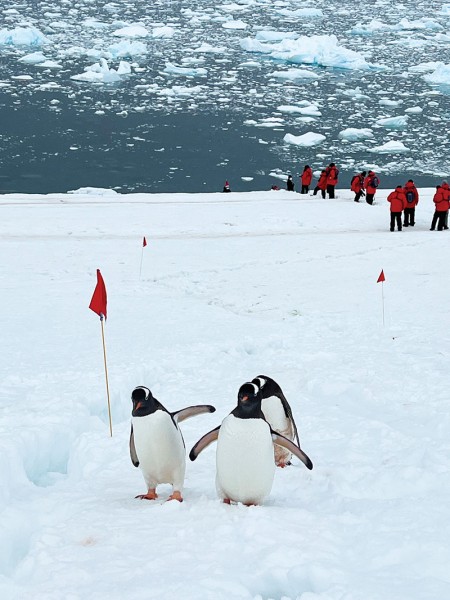
More gentoos make their way back and forth from the coast to their nests on what the locals refer to as a “penguin highway,” while their human observers traverse a path the naturalists dig out for them every morning before the day's outing.
The Antarctic Peninsula has been warming rapidly, five times faster than the global average, and faster than scientists had predicted. Between 1992 and 2017, the continent lost more than 3 trillion tons of ice. The Kramers were able to see some of the dramatic evidence of collapsing ice shelves, caused by warming.
“Because the ice is changing so much, we were able to get to places people aren’t ordinarily able to get to,” said Adam. “That’s for reasons that unfortunately are not conducive to life in the long term, but it allowed us to see the changes – what it looked like before, and after.”
The issue has been very present for him, as sustainability director of his company. “These are not future problems, these are yesterday problems,” he said. “We are behind in the game. We’re going to have to work harder and harder to bring us back to a balanced environment.”
Overall, the experience was an awe-inspiring one, putting them in direct contact with nature and deepening their consciousness of its fragility. For the boys, it was even more engaging than their parents had expected.
Fifteen-year-old Hayden “is an adrenaline junkie and a video gamer, but the nature was so good for him,” said Jennifer. “I thought he would get bored and say, ‘I’ve seen enough penguins.’ But no – he would take out his camera and get hours of footage. He just kind of soaked it all up; he was in love with the whole trip.”
For Dylan, 13, the adventure marked a milestone: his parents had decided on this trip as his Bar Mitzvah gift.
“It started out as a mission to check off his seventh continent,” said Jennifer. “But it ended up being an epic journey that he will remember forever.”
For Adam, it was a strong reminder of the importance of the work he does every day. “I just think we need to appreciate the world and remember how fragile things are,” he said. “Even with a continent the size of Antarctica, as massive and grand as it is, we need to be careful.”
Editor’s note: Buzz travel columnist Tracy L. Barnett is a Lowell Thomas travel journalism award winner and longtime travel and environmental writer. Email her at [email protected] to share your own travel tales.
Want more buzz like this? Sign up for our Morning Buzz emails.
To leave a comment, please log in or create an account with The Buzz Magazines, Disqus, Facebook, or Twitter. Or you may post as a guest.


